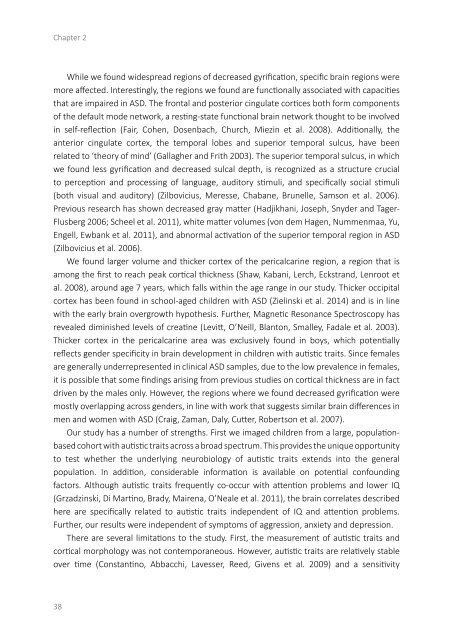On the Spectrum
2lm5UyR
2lm5UyR
Create successful ePaper yourself
Turn your PDF publications into a flip-book with our unique Google optimized e-Paper software.
Chapter 2<br />
While we found widespread regions of decreased gyrification, specific brain regions were<br />
more affected. Interestingly, <strong>the</strong> regions we found are functionally associated with capacities<br />
that are impaired in ASD. The frontal and posterior cingulate cortices both form components<br />
of <strong>the</strong> default mode network, a resting-state functional brain network thought to be involved<br />
in self-reflection (Fair, Cohen, Dosenbach, Church, Miezin et al. 2008). Additionally, <strong>the</strong><br />
anterior cingulate cortex, <strong>the</strong> temporal lobes and superior temporal sulcus, have been<br />
related to ‘<strong>the</strong>ory of mind’ (Gallagher and Frith 2003). The superior temporal sulcus, in which<br />
we found less gyrification and decreased sulcal depth, is recognized as a structure crucial<br />
to perception and processing of language, auditory stimuli, and specifically social stimuli<br />
(both visual and auditory) (Zilbovicius, Meresse, Chabane, Brunelle, Samson et al. 2006).<br />
Previous research has shown decreased gray matter (Hadjikhani, Joseph, Snyder and Tager-<br />
Flusberg 2006; Scheel et al. 2011), white matter volumes (von dem Hagen, Nummenmaa, Yu,<br />
Engell, Ewbank et al. 2011), and abnormal activation of <strong>the</strong> superior temporal region in ASD<br />
(Zilbovicius et al. 2006).<br />
We found larger volume and thicker cortex of <strong>the</strong> pericalcarine region, a region that is<br />
among <strong>the</strong> first to reach peak cortical thickness (Shaw, Kabani, Lerch, Eckstrand, Lenroot et<br />
al. 2008), around age 7 years, which falls within <strong>the</strong> age range in our study. Thicker occipital<br />
cortex has been found in school-aged children with ASD (Zielinski et al. 2014) and is in line<br />
with <strong>the</strong> early brain overgrowth hypo<strong>the</strong>sis. Fur<strong>the</strong>r, Magnetic Resonance Spectroscopy has<br />
revealed diminished levels of creatine (Levitt, O’Neill, Blanton, Smalley, Fadale et al. 2003).<br />
Thicker cortex in <strong>the</strong> pericalcarine area was exclusively found in boys, which potentially<br />
reflects gender specificity in brain development in children with autistic traits. Since females<br />
are generally underrepresented in clinical ASD samples, due to <strong>the</strong> low prevalence in females,<br />
it is possible that some findings arising from previous studies on cortical thickness are in fact<br />
driven by <strong>the</strong> males only. However, <strong>the</strong> regions where we found decreased gyrification were<br />
mostly overlapping across genders, in line with work that suggests similar brain differences in<br />
men and women with ASD (Craig, Zaman, Daly, Cutter, Robertson et al. 2007).<br />
Our study has a number of strengths. First we imaged children from a large, populationbased<br />
cohort with autistic traits across a broad spectrum. This provides <strong>the</strong> unique opportunity<br />
to test whe<strong>the</strong>r <strong>the</strong> underlying neurobiology of autistic traits extends into <strong>the</strong> general<br />
population. In addition, considerable information is available on potential confounding<br />
factors. Although autistic traits frequently co-occur with attention problems and lower IQ<br />
(Grzadzinski, Di Martino, Brady, Mairena, O’Neale et al. 2011), <strong>the</strong> brain correlates described<br />
here are specifically related to autistic traits independent of IQ and attention problems.<br />
Fur<strong>the</strong>r, our results were independent of symptoms of aggression, anxiety and depression.<br />
There are several limitations to <strong>the</strong> study. First, <strong>the</strong> measurement of autistic traits and<br />
cortical morphology was not contemporaneous. However, autistic traits are relatively stable<br />
over time (Constantino, Abbacchi, Lavesser, Reed, Givens et al. 2009) and a sensitivity<br />
38


